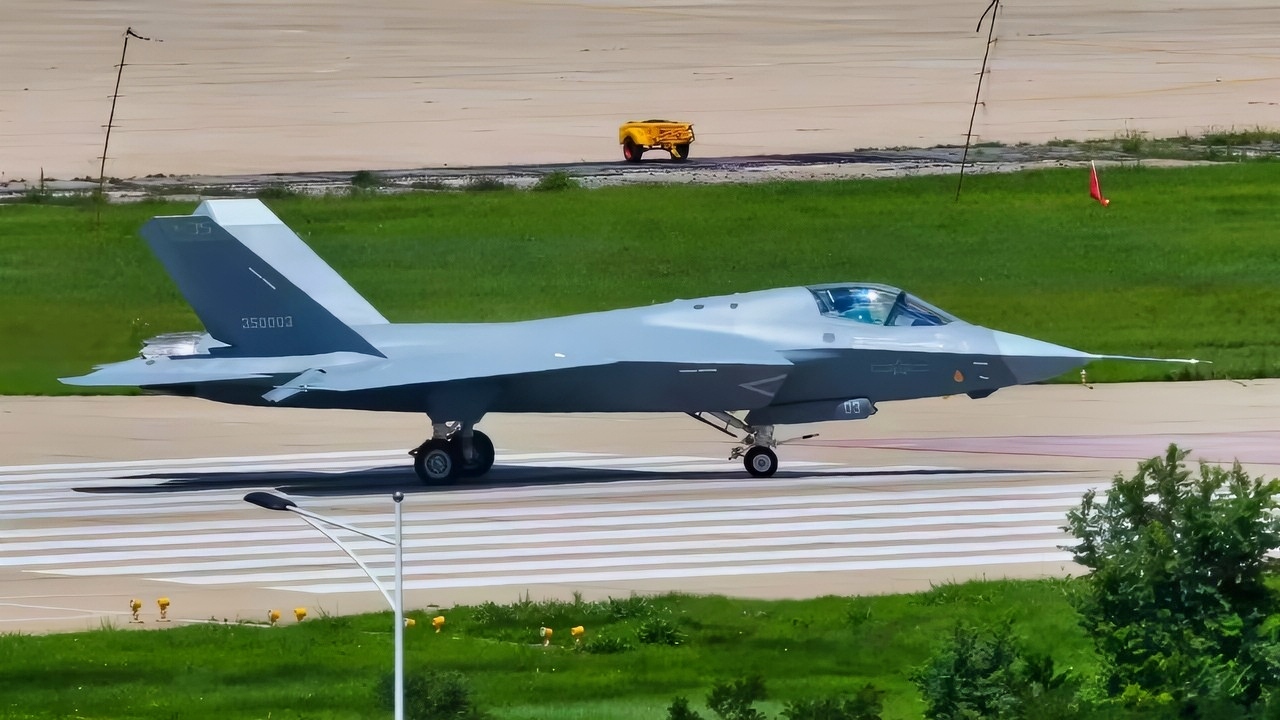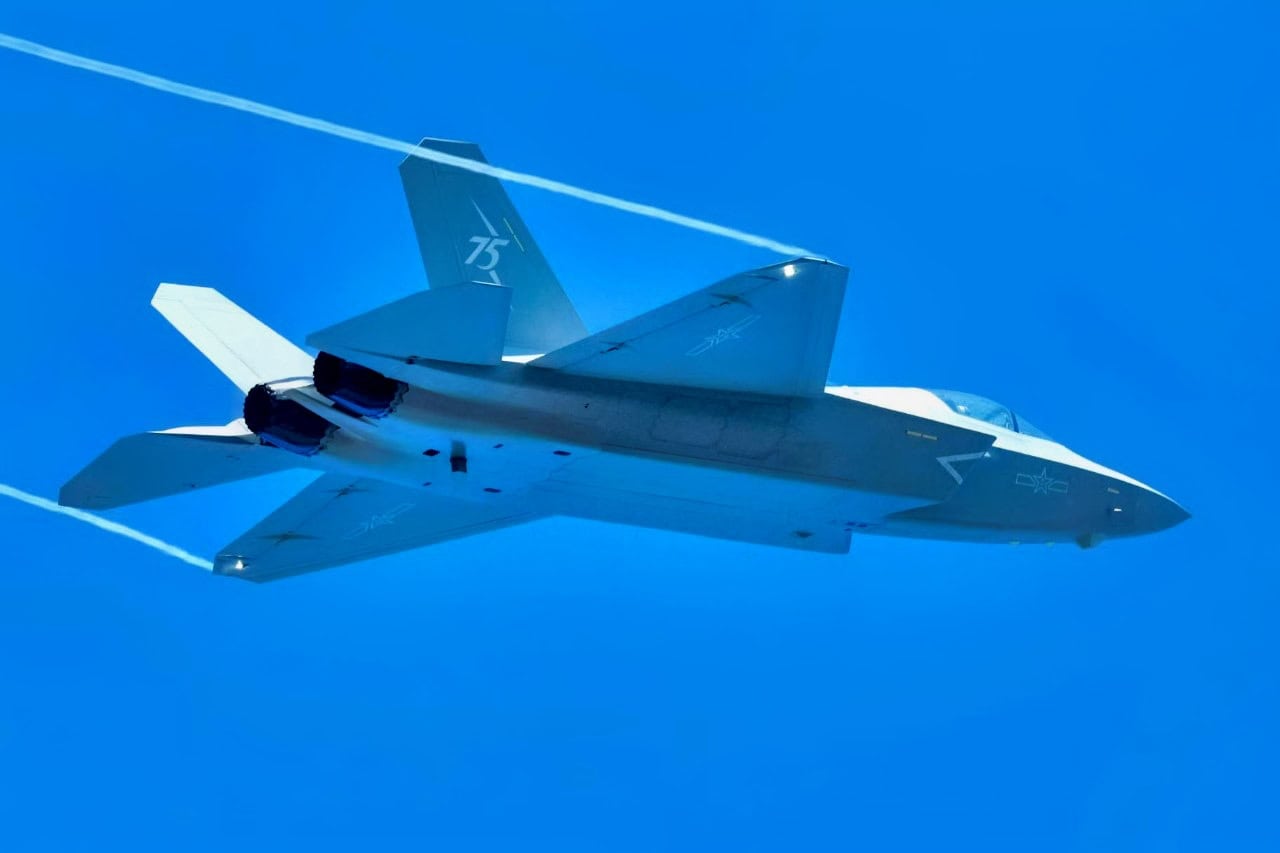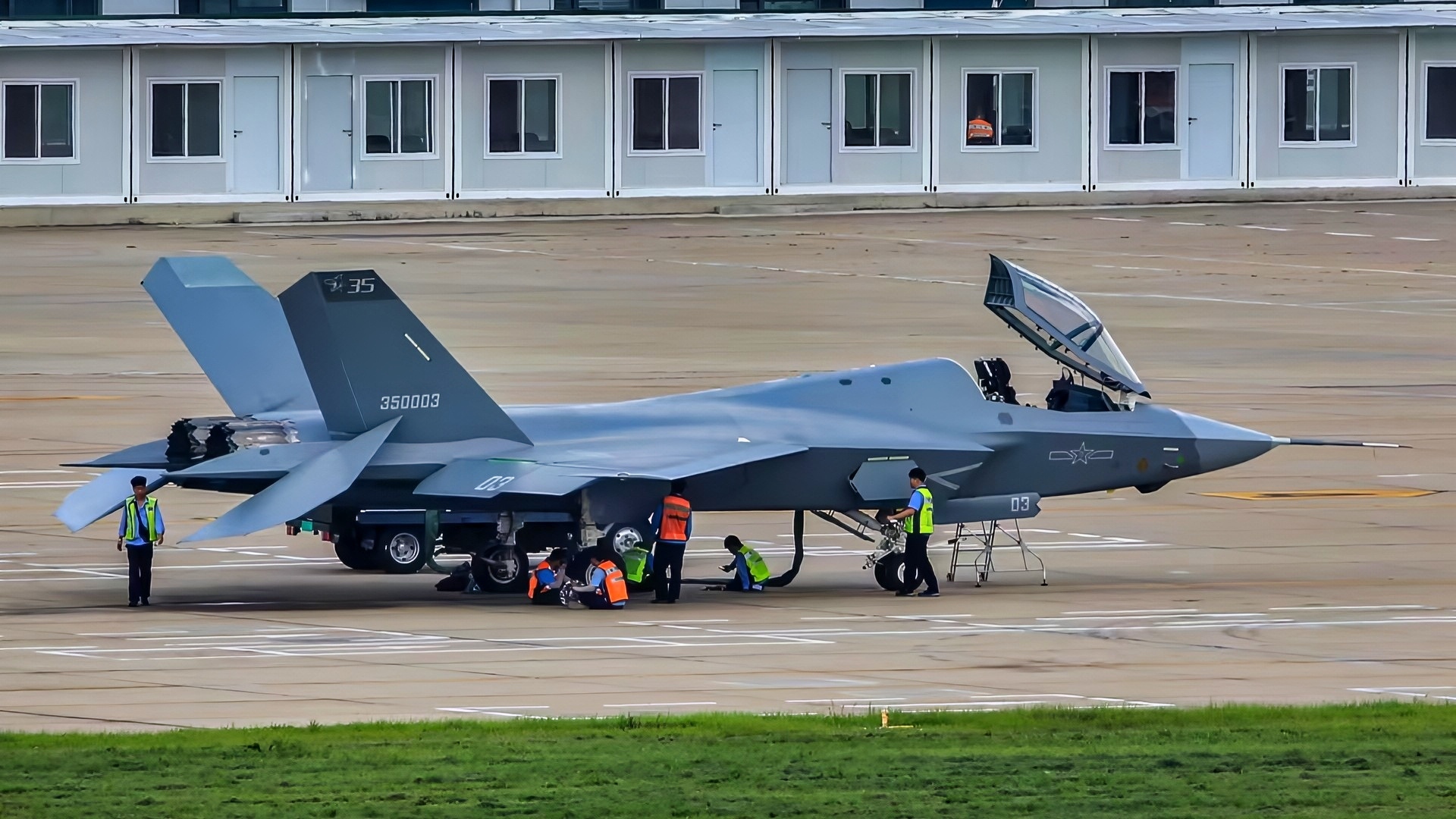Key Points and Summary – China’s J-35A stealth fighter is the land-based cousin of the carrier-oriented J-35, both rooted in Shenyang’s FC-31 lineage.
-Beijing wanted it to complement the heavier J-20: a more numerous, medium-weight, low-observable fighter that plugs into PLA kill chains and pressures U.S. and allied airpower.
-Public debuts and test imagery since late 2024 show a twin-engine, EOTS-equipped airframe with internal weapons bays and next-gen sensors; official performance data remain sparse.
-Compared with the F-35, China is still chasing software maturity, mission-system fusion, and sustainment scale; against the F-22, kinematics and stealth margins likely favor the Raptor.
-Here’s what’s real—and what’s still guesswork.
China’s J-35A: The PLAAF’s Second Stealth Fighter Arrives
The J-35A didn’t start life as a centrally anointed flagship. A decade ago, Shenyang’s FC-31/J-31 appeared as a largely company-driven prototype—a hedge on future export sales and a potential domestic slot if Beijing ever wanted a lighter stealth fighter alongside the heavyweight J-20.
The airframe evolved in fits and starts: new intakes, revised planform, reworked canopy and bays. Then the Chinese navy’s carrier ambitions crystallized, and Shenyang spun a navalized variant toward catapult operations. That carrier path (today’s J-35) gave the design family a customer and a mission.
The J-35A is the land-based fork of that story, tweaked for PLAAF needs instead of catapult decks: different nose gear, wing geometry, vertical tails, and avionics/software tuned for air-force operations. Public showings in late 2024 offered the first close look at a jet that had long been rumored but rarely seen; since then, appearances and official hints have filled in outlines without surrendering hard numbers. That is deliberate. China’s aviation complex has learned to reveal just enough—shape, role, and theater—while keeping performance and software detail behind the curtain.
Why China Wanted The J-35A
If you already fly the J-20, why add another stealth fighter? The logic is force-design, not vanity.
Mass At A Manageable Price. The J-20 is a big, long-range thoroughbred with a premium radar and growing engine power. It is also expensive. A medium-weight, twin-engine stealth jet offers more tails on ramps and more sorties per budgeted yuan, which matters for a military planning to fight under a dense umbrella of surface-to-air missiles, long-range radar, and datalinked shooters.
A Second Stealth Line For A Second Mission Set. The PLAAF doesn’t just need long-range interceptors; it needs a multi-role stealth fighter that can hunt aircraft and cruise missiles, escort high-value assets, and work near contested coastlines where fuel, maintenance, and runway considerations favor a smaller airframe.
A Software-Defined Sensor Node. Chinese sources have framed the J-35A as a “kill-chain” fighter—an aircraft that not only shoots, but also discovers, classifies, and cues other weapons. Think counter-stealth surveillance of inbound threats, networked targeting for ground and maritime strikes, and cooperative engagements with SAMs, ships, and other aircraft. In other words, less lone-wolf, more quarterback.
A Regional Signaling Tool. Finally, there’s a political layer: fielding two different stealth fighters puts China in a club previously occupied by a single country—the United States. Even if raw capability isn’t parity, the optics shape regional perceptions and procurement debates from Tokyo to Taipei to Canberra.
What The Airframe Tells Us—And What It Doesn’t
Seen up close, the J-35A presents a modern stealth silhouette: internal bays, a blended forebody, canted tails, edge alignment, serrated access panels, and a chin-mounted electro-optical/IR turret broadly analogous in placement to the F-35’s EOTS. The naval sibling features folding wings and a catapult launch bar, while the air force J-35A omits these, adopting a single-wheel nose gear and a smaller wing for improved land-based performance.
Imagery and reporting suggest continuing propulsion work—from interim engines in early prototypes to an indigenous WS-19-class path for production—but definitive thrust ratings, fuel fractions, and radar aperture sizes remain guarded.

J-35A Fighter Chinese Military. Image Credit: Creative Commons.
Stealth is the hardest piece to judge from photos. A clean planform is necessary, not sufficient. Materials, coatings, panel fit, and seal management at tempo are where programs live or die. Here China is improving—but outsiders should be cautious about assuming equivalence with the F-35’s very mature low-observable ecosystem. That said, each generation of Chinese stealth jets shows tighter manufacturing tolerances and more sophisticated surface treatments than the last.
The Operational History (So Far): Public Debuts, Quiet Testing
Because the J-35A is new, its track record comes mostly in glimpses: taxi runs, short flight demos, and tightly curated media moments at Zhuhai; satellite and telephoto proofs of additional prototypes; and quotes from Chinese engineers sketching how the jet would fit a counter-stealth, networked air-defense concept. Western trade press and wire services corroborate the basics: the public debut timeline, the split between carrier and land variants, and China’s intent to field the type in meaningful numbers.
What we still don’t have is the unglamorous data that make or break a fleet: mission-capable rates, software stability in the field, sensor fusion quirks, and the bruises that come from large-force exercises. Those tend to surface years after a type enters regular service. Until then, the best reading is that the J-35A is transitioning from prototypes to initial units, while the carrier variant feeds the navy’s air wing ambitions. Expect months (and likely years) of iterative updates to radar modes, EW techniques, and datalink behavior before anyone can call the jet “mature.”
How Beijing Likely Plans To Use It
Picture the airspace over the First Island Chain on a bad day. Long-range radar and passive sensors build a track picture. Patrol aircraft hunt submarines. Ships launch and recover unmanned systems. In this ecosystem, a medium-weight stealth fighter can play three complementary roles:

J-35A Fighter at Le Bourget Air Show. Image Credit: Author/National Security Journal.
Counter-Stealth Interceptor. Hunting low-observable aircraft and cruise missiles that slip past the outer belt, using high-gain radar modes, IR sensors, and datalinked tracks from ground and airborne partners.
Escort And Screen. Flying cover for tankers, AEW&C, and bombers with less penalty to numbers than tasking the heavier J-20 for every sortie.
Quiet Striker And Cue-Giver. Carrying a small internal load for time-sensitive targets while acting as a sensing node that enables long-range fires from ships, coastal batteries, or other aircraft.
Because the PLAAF favors mass and persistence, a “good-enough, numerous” stealth fighter paired with a smaller but exquisite J-20 cadre makes strategic sense. The J-35A is the mass half of that equation.
J-35A Vs. F-35: The Real Gap Is Invisible
The F-35 is the wrong yardstick in one way and the right one in another. On paper the airframes rhyme—internal bays, stealth shaping, a chin EO sensor, and emphasis on networking. Where the F-35 differentiates itself is less aerodynamic than informatic: thousands of jets, millions of flight hours, decade-plus of software sprints, and a sustainment ecosystem that—despite its headaches—supports a vast, multinational fleet. The sensor fusion story is crucial. It’s not just the radar or EOTS; it’s how tracks from every sensor and partner become a single, stable picture across a four-ship, a squadron, and a strike package.

J-35 Fighter X Screenshot. Image Credit: X Screen Capture.
China can and will write powerful code, but software maturity is earned at scale with brutal feedback from exercises, deployments, and coalition ops. Training pipelines, tactics development, EW libraries, mission-data reprogramming, and secure data links are where fifth-gen lives day-to-day. If the J-35A is to rival the F-35 in effect, the gap to close is less about wing loading and more about firmware—and the human machine that iterates it.
There’s also sustainment. Stealth jets are maintenance-intensive; coatings and panel alignment don’t survive sloppy processes. The F-35 community has spent years learning how to keep low observability intact on rainy tarmacs with crews rotating at 2 a.m. The PLAAF can replicate much of this, but it will take time, and the learning curve will be steep and public.
J-35A Vs. F-22: A Different Kind Of Fight
Against the F-22, the comparison tilts toward kinematics and signature. The Raptor’s supercruise, thrust-vectoring, and extreme emphasis on front-aspect stealth were designed for air dominance against peer fighters and dense SAM belts. If a fight devolves to energy maneuvering, the F-22 holds the cards. Where the J-35A could complicate a Raptor’s day is numbers, networking, and angles—arriving from unexpected vectors with long-range missiles cued by offboard sensors, or acting as silent spotters that force Raptors to defend instead of dictate.
In practice, a future U.S.–China air battle would be larger than any two types: F-35s, F-15EXs, EA-18Gs, E-7s, MQ-25s, submarines, and surface shooters on one side; J-20s, J-35As, KJ-500s, H-6 variants, unmanned decoys, and layered SAMs on the other. The J-35A makes that Chinese web tighter. It does not make the F-22 obsolete.
Engines, Weapons, And The “Good Enough” Threshold
Engines are the long pole in every fifth-gen tent. Reporting points to a pathway toward a WS-19-class powerplant for the air-force variant and WS-21/WS-13-series work for prototypes. If those engines deliver reliable thrust and thermal margins, Beijing can field the J-35A in useful quantities even if peak performance trails Western benchmarks. Likewise, weapons fit will lean on China’s modern air-to-air missiles—notably PL-15-class beyond-visual-range rounds and PL-10-class high-off-boresight weapons—carried internally to preserve signature. Precision surface attack from the bays would round out the role set.

J-35 Fighter. Image Credit: X/Screenshot.

J-35 Fighter. Image Credit: Chinese State Media.
The “good enough” threshold is not an insult; it’s a strategy. A stealth fighter that is good enough to fuse, good enough to hide, and cheap enough to field in numbers is dangerous in a region where the distances are long and the timelines are short.
What We’ll Be Watching Next
A few markers will tell you whether the J-35A is maturing:
Engines In The Wild. When production jets fly with stable indigenous engines across climates and tempos, the program has cleared a major hurdle.
Unit Photos And Exercises. Imagery of multiple aircraft at the same base, repeated appearances in large-force exercises, and hints of adversary training against the type signal confidence.
Avionics Upgrades. Trade-press notes about new radar modes, EW updates, and mission-data reprogramming pipelines mean the software machine is spinning.
Integration With The Navy. A visible division of labor with the carrier-borne J-35—and shared tactics across services—would show a mature joint concept, not just parallel procurement.
J-35A In 4 Words: Good Enough Stealth Fighter?
The J-35A isn’t a clone of the F-35 or a peer to the F-22. It doesn’t need to be. It needs to be available, survivable, and networked—and fielded in enough numbers to force U.S. and allied planners to assume stealth opponents at scale. On that score, China’s decision to adopt a second stealth type looks coherent: the J-20 remains the long-reach spear, while the J-35A becomes the everyday stealth fighter that thickens air defenses, escorts critical assets, and quietly sets up shots for others.
The open questions are the important ones: engines, software maturity, sustainment discipline, and training at scale. If Beijing closes those gaps, the J-35A won’t just be a headline jet at air shows; it will be the plane that makes the air picture noisier, the targeting chains faster, and the margin for error narrower from the Yellow Sea to the Philippine Sea. That, more than any spec sheet, is why it matters.
About the Author: Harry J. Kazianis
Harry J. Kazianis (@Grecianformula) is Editor-In-Chief and President of National Security Journal. He was the former Senior Director of National Security Affairs at the Center for the National Interest (CFTNI), a foreign policy think tank founded by Richard Nixon based in Washington, DC. Harry has over a decade of experience in think tanks and national security publishing. His ideas have been published in the NY Times, The Washington Post, The Wall Street Journal, CNN, and many other outlets worldwide. He has held positions at CSIS, the Heritage Foundation, the University of Nottingham, and several other institutions related to national security research and studies. He is the former Executive Editor of the National Interest and the Diplomat. He holds a Master’s degree focusing on international affairs from Harvard University.
More Military
The U.S. Army’s Big Strategic Long Range Cannon (1,150 Mile Range) Mistake Still Stings
The F-4 Phantom II Has a Message for the U.S. Military
The Iowa-Class Battleships Have a Message for the U.S. Navy
Russia’s Kirov-Class Battlecruisers Have a Message for the U.S. Navy
Russia’s PAK DA Stealth Bomber Has a Message for the U.S. Air Force











Z
September 19, 2025 at 5:31 pm
China’s planes will make it half way to the target and explode!
Jay
September 21, 2025 at 7:22 pm
Copy of US F-35. Will turn out to be a POS!
Garth Giles
September 21, 2025 at 10:00 pm
This article sums it up in a million words. I still haven’t found the 4 word summation.